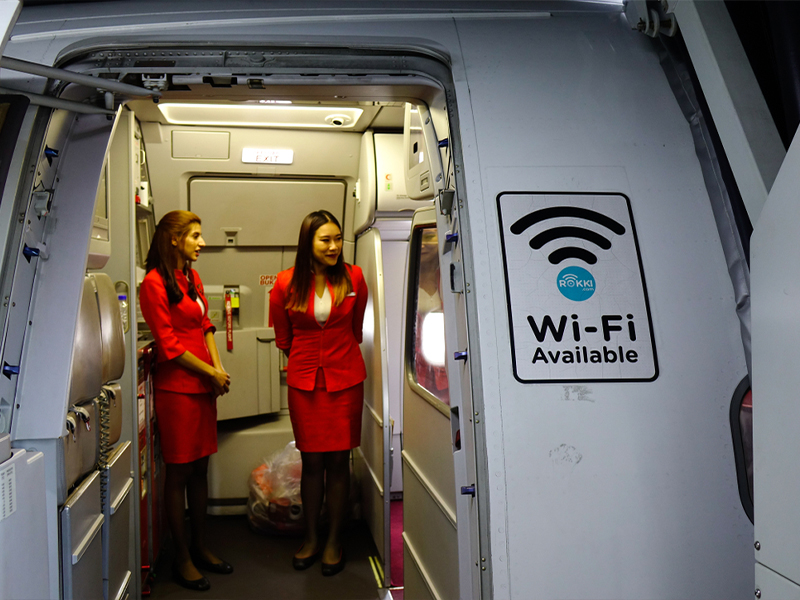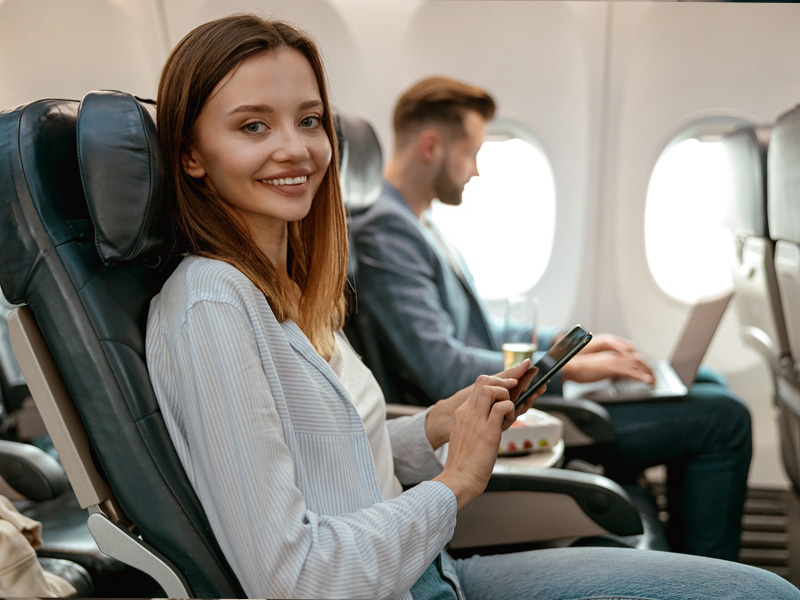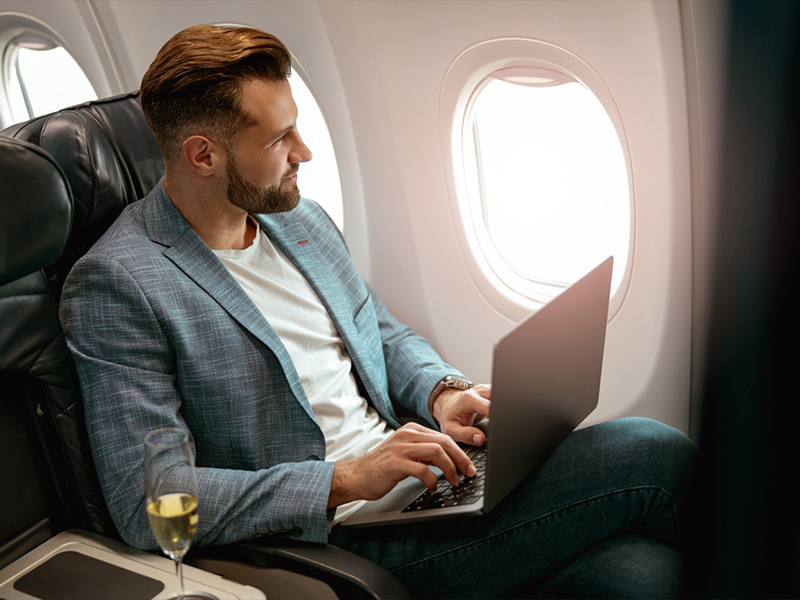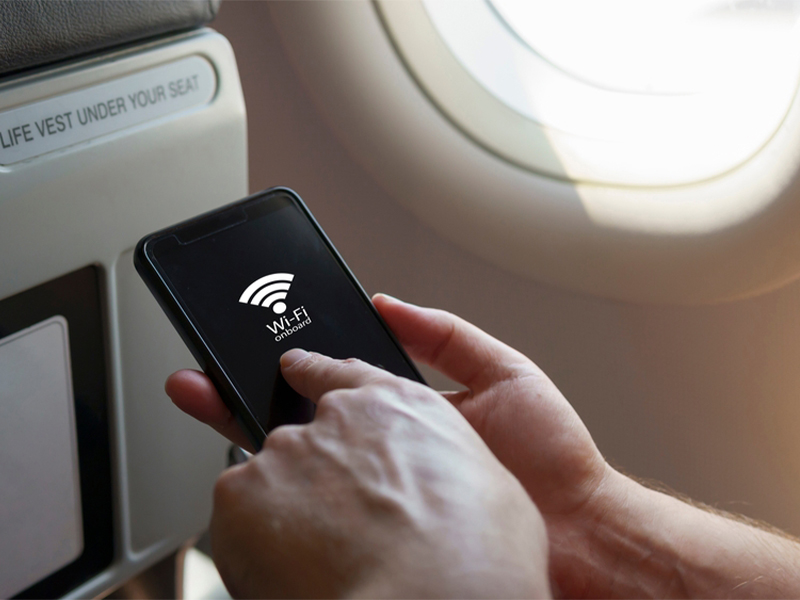Given the undeniable fact that today we all have undoubtedly developed a great habit of using the internet and virtual world in some way, it can be said without any doubt that we will not give up on the possibility of using the benefits of the internet even in the most impossible places. Today, we want to examine for you the mechanism of using Wi-Fi Internet on airplanes. Join us at Eligasht to explore how Wi-Fi internet works on airplanes.
Book flights to all over the world with Eligasht UK
Wi-Fi Internet on Airplanes
Have you ever been able to use high-speed internet over the skies while on an airplane? Previously, the law was that using a phone was prohibited due to the interference its signals caused during flight, and although this is still the case for most airplanes, some airlines have created the possibility for their passengers to use Wi-Fi internet during their flights after various tests and courses.
However, it should be noted that some airlines offer this service for free, while others charge a separate fee. Now the question arises as to how airplanes connect to Wi-Fi internet during the flight and how passengers can access the internet despite signal interference. Technically, there are only two ways to connect to Wi-Fi internet on airplanes.
In these methods, one way is via satellite, which is currently known to be very expensive, so airlines tend to use the second method. Wi-Fi on airplanes is connected to ground-based communication towers. The way it works is that the equipment for sending and receiving internet waves is installed on the same communication towers that are used for mobile phones and are also installed for Wi-Fi internet on airplanes.
it should not be assumed that these two methods are the same, as they differ in that the waves used for mobile phones are terrestrial, while the equipment we are talking about sends waves toward the sky and airplanes. Another difference is that during the flight, the airplane repeatedly switches its internet connection between each of these communication towers to always maintain internet connectivity for passengers.
Of course, this technology has not yet been implemented in all airlines around the world, but in countries like the United States, Wi-Fi internet on airplanes has become a common feature. Therefore, a widespread network has been implemented over the past few years to offer in-flight internet programs for these airlines.

Wi-Fi Internet on Airplanes: how is it possible?
The contractor responsible for providing Wi-Fi internet on airplanes is a company called GoGo, which is responsible for designing and implementing communication between these lines. However, the question arises as to what happens to internet access in places where it is impossible to install and have communication towers. Based on experience, it has been proven that in-flight internet has been limited to areas where terrestrial communication towers are available, and passengers had to say goodbye to the internet wherever the flight was over the sea and ocean.
But airlines have thought about solving this problem and have also decided to offer their internet services on international flights, and for this purpose, they have turned to satellites. Some airlines use L-band technology to transmit satellite waves, which is currently slow and relatively expensive, which is why ku-band technology with higher frequencies (12 to 18 gigahertz) has been replaced as a more cost-effective and better-performing alternative.
The internet system on Lufthansa flights claims that the download speed on this airplane reaches over 50 megabytes, which is not insignificant. Although using satellite for the internet is more expensive and requires more and heavier equipment to be installed on airplanes, it seems that more airlines are willing to do this for their airlines.
For example, Lufthansa, an airline from Germany, currently offers satellite internet to its passengers on some international flights. Similarly, many other airlines have decided to implement satellite internet for their international flights. Norwegian and Turkish Airlines also offer free internet to their passengers. Meanwhile, Scandinavian airlines are recently testing this free service on some of their planes.

Wi-Fi Internet on Airplanes: The Pros and Cons
In the past, air travel meant complete disconnection from the outside world. Passengers had to rely on in-flight entertainment systems or read books to pass the time. However, with the advent of Wi-Fi on airplanes, this has changed. Now, passengers can stay connected to the internet during their flight, allowing them to stay in touch with friends and family, work remotely, or simply browse the web. In the following, we will explore the pros and cons of Wi-Fi Internet on airplanes.
Pros:
Stay Connected: One of the biggest advantages of Wi-Fi on airplanes is that passengers can stay connected to the internet during their flight. This allows them to stay in touch with friends and family, work remotely, or simply browse the web. Passengers can also use social media platforms to share their travel experiences in real time.
Productivity: Business travelers can take advantage of Wi-Fi on airplanes to stay productive during their flights. They can use the internet to work on documents, attend virtual meetings, or communicate with colleagues.
Entertainment: Wi-Fi on airplanes also allows passengers to access a wide range of entertainment options. They can stream movies, TV shows, or music, and play online games. This can help make long flights more enjoyable.
Convenience: Wi-Fi on airplanes is also convenient for travelers who need to make last-minute travel arrangements, check in for their next flight, or book accommodations at their destination.
Cons:
High cost: The cost of airline internet on Qatar and other airlines can be expensive. Therefore, you have to pay a lot of money for the connection. This means that you have to pay a lot of money for loading a simple and normal website. Because the amount of internet available to passengers is very low and the cost paid is high compared to the amount of internet.
Some airlines offer multiple types of internet to passengers. In the cheaper type, you can only use social messengers for chatting and there is no possibility for heavier tasks. In the other type, you can use a stronger internet by paying more. For example, in the first type, you cannot send heavy files, but in the second type, it is possible.
Restrictions on using websites: Many websites are blocked during the flight and cannot be used. For example, on some airlines, you cannot use Snap Chat and Twitch.
Slow speed: Another problem with using the internet during the flight is its low speed. Therefore, it is not easy to open high-volume videos and images. For example, it may take 3-4 minutes to load an image with a size of 1.5 megabytes. The upload speed is also very slow. Simply put, Wi-Fi during the flight cannot be compared to home internet or 4G/5G mobile connections. When a large number of passengers try to use the limited bandwidth, problems always arise. In some cases, there are also usage restrictions. For example, each passenger can use up to 500 megabytes of internet.

airlines around the world that offer Wi-Fi
- Delta Air Lines: Delta is one of the leading airlines when it comes to in-flight Wi-Fi. They offer Wi-Fi on all domestic flights and most international flights.
- American Airlines: American Airlines offers Wi-Fi on most of their domestic flights and select international flights.
- United Airlines: United Airlines offers Wi-Fi on most of their domestic flights and select international flights.
- Emirates: Emirates offers Wi-Fi on all of their Airbus A380 and Boeing 777 aircraft.
- Qatar Airways: Qatar Airways offers Wi-Fi on most of their flights, including long-haul flights.
- Singapore Airlines: Singapore Airlines offers Wi-Fi on most of their flights, including long-haul flights.
- Cathay Pacific: Cathay Pacific offers Wi-Fi on most of their flights, including long-haul flights.
- Virgin Atlantic: Virgin Atlantic offers Wi-Fi on most of their flights, including long-haul flights.
- JetBlue Airways: JetBlue Airways offers free Wi-Fi on all of their flights.
- Southwest Airlines: Southwest Airlines offers Wi-Fi on all of their flights.
Wi-Fi availability can vary depending on the route and aircraft type. Additionally, some airlines offer free Wi-Fi, while others charge a fee for access. Be sure to check with the airline before your flight to see if Wi-Fi is available and if there is a cost associated with accessing it.
Conclusion
Wi-Fi internet on airplanes has revolutionized air travel, providing passengers with access to the internet and a range of online services during their flights. It has become an essential amenity for many travelers, allowing them to stay connected, be productive, and access entertainment and services. While Wi-Fi availability and cost can vary depending on the airline and route, many airlines around the world now offer Wi-Fi on their flights, with some even providing it for free. As technology continues to improve, Wi-Fi internet on airplanes is likely to become even faster and more widespread, providing travelers with an even better in-flight experience. If you have any experience with Wi-Fi internet on airplanes, please share it with us.
